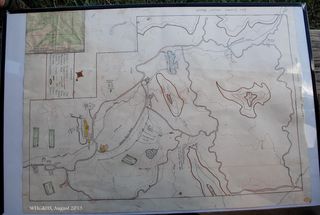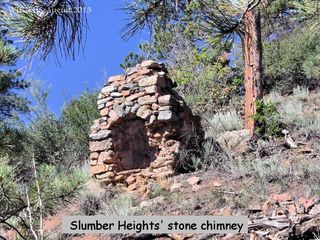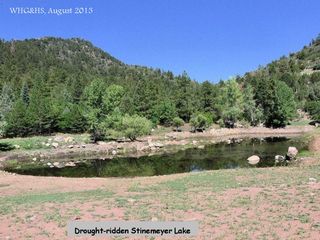Some photos of each of the stops on the tour can be found at the end of this posting. Be sure to view more of the tour photos taken by Dave Alexander, Sam Carlsson and Peggy Martin in the Trinity Ranch Photo Album HERE
On Saturday, August 10th, forty eager men and women met at the entrance to Dr. and Mrs. Robert Hamilton’s Trinity Ranch. We drove inside the main entrance and then walked to the Breece Homestead cellar where Peggy Breece Martin shared the early history of her great-grandfather, Horatio Hall Chivington Breece. She shared information about the original 7 pioneers who homesteaded the land making up the land of the Diocese of Colorado and the J. L. Draper ranch. Martin also talked about the first irrigation ditches and how they supplied water to the various fields, the fruit orchards planted and the fruit and vegetables sold to the various early communities. Joan Hamilton distributed handouts about the early inhabitants of the Draper Cave, Hardscrabble Settlement, Slumber Heights, and Lake Stinemeyer.
From the cellar, we carpooled up to the actual Breece log home for an opportunity to see both interior and exterior views of this 100 year plus old house. The attendees were able to climb the stairs to the second floor and observe where the kitchen addition had been built. It is currently separate but will be rejoined in the future.
Our next stopping point was the area of Slumber Heights, further up the mountain, and a steep incline from the road. The Heights were cabins built by several Florence businessmen that now are crumbled but with two and one half chimneys standing. One and one half chimneys are stone while the other is brick. The view barely shows the lake below. On the hike up to this area, the group was astonished by a huge mushroom, probably a good 8 to 10 inches in diameter. Peggy Martin, Bill Hall and Dick Doman all related that it was a “puff ball”, the Indians and early settlers would scrape the under interior to use as a coagulant for scratches and bleeding wounds. Dick also said that they would slice them and then cook them as one would eggplant; he said they were good eating.
Coming down from the Heights, we next stopped at Stinemeyer Lake. Walking down to the “Lake”, one was engulfed in the beauty of the mountains and cliffs surrounding it. There were tracks in the mud of animals using the hole for watering, birds called out at the disruption, and yet the quiet was awe inspiring. The geologists with us were amazed at the varieties of rock and stone in such a small area.
Back to the vehicles and down to the Monks’ House for a potty break and water to keep us hydrated. This afforded another good opportunity to chat with our new friends while we waited. Nate Hobson found a beautiful arrowhead that he gave to Joan.
Loading up again, we wound our way after our leader, Dr. Robert Hamilton, as he took us across several fields and then up a short ways to the William Tennant homestead. Dave Alexander, great-great-grandson of Tennant, told us how Tennant emigrated from England where he had been a stone mason. He married Rachel MacGregor and they had two daughters, Minna and Ida. Rachel died young and Tennant remarried; Almina Wright Dolph Tennant raised the daughters. Alexander’s handout included two photos taken by Broome Brothers of Pueblo – one of the family in front of their home and the other, the fantastic view from their ranch looking towards Pikes Peak and eastward. The foundation remnants, terraces, and pump house with water pipes are still visible and so very interesting.
Hiking up the mountain to the west of the Tennant homestead, we arrived at Draper Cave. Alexander had given us a handout with physical setting, soil evidence, archaic human occupation, and human remains information he had obtained about a prior “dig” of the Cave. Armed with this, we were anxious to hear the story of George Washington and Mary Jane Moxley Heath who lived in the cave for two years upon their arrival (1870) to the Hardscrabble. Eventually, the land wound up as part of the George and Leona Sullivan Draper ranch. It was they who authorized the archeological dig in the 1970’s by the University of Colorado. It is important to note that the water supply for the cave came from Tennant Gulch with the mouth of the cave 13 feet above the bank of the stream (now dry). Jerry and Buddy Draper continued the story of Buddy’s family, including the many years of providing stock and being stunt doubles for the movies – Vengeance Valley, Cat Ballou, Connagher and The Cowboys to name a few. The area is scenic and full of historic Custer County evidence of prior animal and human occupation.
It was time to return to the Lodge area and the Pavilion for our lunch and time to absorb what we had seen. We were treated by Bill Howell to a review on Texan Charles Goodnight, his ranch, and his influence in Texas, New Mexico and Colorado as we rested our weary legs. It was interesting to learn that it was Goodnight who invented the chuckwagon. Joan and Jerry laid out maps and movie posters for our enjoyment as well.
It is with much appreciation that we offer our “thank you” to Robert and Joan Hamilton for their hospitality, providing drinks and sharing Trinity Ranch with WHG&HS and our guests. Thank you, too, to each of the presenters along our journey.
All in all, it was a fulfilling day rich in ancestral history, awesome natural beauty and new friendships!
Margaret Storm,
President, WHG&HS
August, 2013
Trinity Ranch Map
Breece Homestead:
Slumber Heights:
Stinemeyer Lake
Monk's House
Tennant Homestead
Draper Cave

























Comments